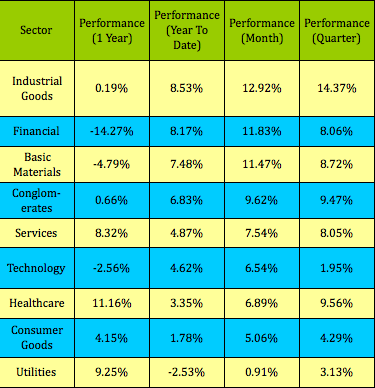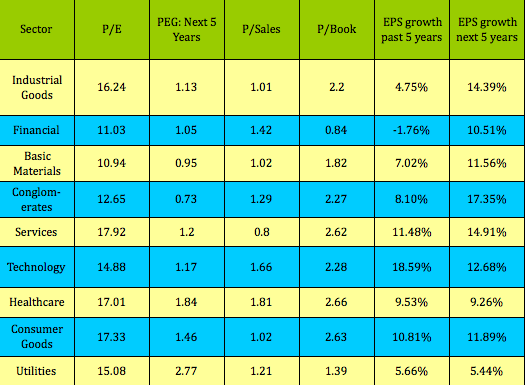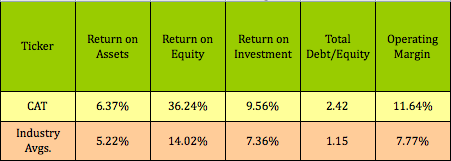Although it’s nearly flat for the past year, the Industrial sector has been rising strongly over the past few months:
Promising earnings forecasts are one of the main reasons for this sector’s momentum, as it’s projected to be one of the top sectors for EPS growth over the next 5 years:
So far, Caterpillar, (CAT), has been one of the best stocks to buy in 2012 for price gains. If you bought CAT in late 2011, you’d have a nice gain already:
Although the market has been climbing so far in 2012, many analysts are forecasting a volatile road ahead in the first half of 2012. So how can you protect your gains in CAT?
Fortunately, CAT has some of the highest options yields of any Dow dividend stocks, which will help you to protect a large % of your gains, via selling covered calls.
Different strategies you can use to hedge your gains and earn high yields:
1. Sell covered call options further out in time, to capture a bigger premium, and hedge more of your gains. This table uses CAT’s 2011 year-end price as a cost basis, and illustrates how, the further out in time you sell these $105.00 call options, the more option premium $ you’ll receive.
In the table below, the May option pays $7.50, which hedges almost 50% of the $15.11 year-to-date gain for CAT, whereas the Jan. 2013 option pays $13.65, which hedges over 90% of the gain. The higher, longer-term call premiums will also lower your break-even price.
The trade-off is that your annualized yields decrease as you sell further out in time. However, all of these trades achieve double-digit annualized “static yields”, and much higher potential assigned yields. Static yield equals the call bid premium dividend by the cost basis of the underlying stock, and refers to a scenario in which the stock doesn’t rise above the strike price near expiration, so you keep the underlying shares:
(You can see more details on over 30 high yield Covered Call trades which we’ve discussed in recent articles in our Covered Calls Table.)
2. If you’re more bullish on the market and/or CAT, you could sell covered call options at a higher strike price, leaving yourself more opportunity for future price gains.
The table below uses CAT’s 1/19/12 closing price as a cost basis, and shows the differences in potential price gains at different strike prices, all expiring in August 2012.
Potential assigned yield refers to the yield on the difference between the stock’s price and the strike price.
In this example, the $105.00 strike price is $.71 below CAT’s $105.71, so if the stock rises above $105.00 near expiration time in August, the underlying shares may get sold/assigned away from you at $105.00. This is the big trade-off of selling covered calls at a strike price “in the money” – you sacrifice potential future price gains for a higher option payment now.
The other two higher strike prices leave you more room for potential price gains/higher potential assigned yields, but pay lower call option premiums:
The above call options pay almost 6 to over 10 times the amount that CAT’s dividends pay during this 7-month trade period.
Selling Cash Secured Put Options:
Conversely, if you’re interested in buying CAT, but you’re leery of its current price, you can sell cash secured puts at a strike price below CAT’s current price, and achieve a lower break-even price.
Selling put options obligates you to potentially have to buy the underlying stock at whatever strike price you sell the puts at. “Cash reserve” refers to the amount your broker will set aside in your account, to insure that you have the money to pay for the stock, if it gets sold/assigned to you at expiration. For example, the $105.00 strike price requires a cash reserve of $10,500.00, which equals $105.00 x 100 shares of CAT. (Each option contract corresponds to 100 shares of the underlying stock)
In these August 2012 put options trades, each lower strike price gives you a lower break-even, but also has a lower option premium. So, you have to decide how aggressive to be – should you “nibble at the edges”, and sell put options further out of the money for a lower break-even, such as the $97.50 strike price below, OR, be more aggressive, and sell at a strike price closer to a stock’s current price, such as the $105.00 strike?:
(Note: You can find more info on over 30 high yield Cash Secured Puts trades in our Cash Secured Puts Table.)
Financials: CAT’s mgt. efficiency ratios are higher than its peers’. CAT’s Debt/Equity ratio is higher, but it has an Interest Coverage ratio of 5.9:
Valuations: Although CAT’s Price/Book is much higher than its peers, it appears undervalued on a PEG basis, and has enjoyed solid growth during its most recent quarter and fiscal year. CAT is due to give its earnings report on Jan. 26, 2012.
Disclosure: Author is short CAT put options.
Disclaimer: This article is written for informational purposes only and isn’t intended as investment advice.
- English (UK)
- English (India)
- English (Canada)
- English (Australia)
- English (South Africa)
- English (Philippines)
- English (Nigeria)
- Deutsch
- Español (España)
- Español (México)
- Français
- Italiano
- Nederlands
- Português (Portugal)
- Polski
- Português (Brasil)
- Русский
- Türkçe
- العربية
- Ελληνικά
- Svenska
- Suomi
- עברית
- 日本語
- 한국어
- 简体中文
- 繁體中文
- Bahasa Indonesia
- Bahasa Melayu
- ไทย
- Tiếng Việt
- हिंदी
Make Over 20 % By Hedging This Top Dow Dividend Stock
Published 01/20/2012, 02:09 AM
Updated 07/09/2023, 06:31 AM
Make Over 20 % By Hedging This Top Dow Dividend Stock
Latest comments
Loading next article…
Install Our App
Risk Disclosure: Trading in financial instruments and/or cryptocurrencies involves high risks including the risk of losing some, or all, of your investment amount, and may not be suitable for all investors. Prices of cryptocurrencies are extremely volatile and may be affected by external factors such as financial, regulatory or political events. Trading on margin increases the financial risks.
Before deciding to trade in financial instrument or cryptocurrencies you should be fully informed of the risks and costs associated with trading the financial markets, carefully consider your investment objectives, level of experience, and risk appetite, and seek professional advice where needed.
Fusion Media would like to remind you that the data contained in this website is not necessarily real-time nor accurate. The data and prices on the website are not necessarily provided by any market or exchange, but may be provided by market makers, and so prices may not be accurate and may differ from the actual price at any given market, meaning prices are indicative and not appropriate for trading purposes. Fusion Media and any provider of the data contained in this website will not accept liability for any loss or damage as a result of your trading, or your reliance on the information contained within this website.
It is prohibited to use, store, reproduce, display, modify, transmit or distribute the data contained in this website without the explicit prior written permission of Fusion Media and/or the data provider. All intellectual property rights are reserved by the providers and/or the exchange providing the data contained in this website.
Fusion Media may be compensated by the advertisers that appear on the website, based on your interaction with the advertisements or advertisers.
Before deciding to trade in financial instrument or cryptocurrencies you should be fully informed of the risks and costs associated with trading the financial markets, carefully consider your investment objectives, level of experience, and risk appetite, and seek professional advice where needed.
Fusion Media would like to remind you that the data contained in this website is not necessarily real-time nor accurate. The data and prices on the website are not necessarily provided by any market or exchange, but may be provided by market makers, and so prices may not be accurate and may differ from the actual price at any given market, meaning prices are indicative and not appropriate for trading purposes. Fusion Media and any provider of the data contained in this website will not accept liability for any loss or damage as a result of your trading, or your reliance on the information contained within this website.
It is prohibited to use, store, reproduce, display, modify, transmit or distribute the data contained in this website without the explicit prior written permission of Fusion Media and/or the data provider. All intellectual property rights are reserved by the providers and/or the exchange providing the data contained in this website.
Fusion Media may be compensated by the advertisers that appear on the website, based on your interaction with the advertisements or advertisers.
© 2007-2024 - Fusion Media Limited. All Rights Reserved.
